
|   |

|   |
Purush: Male Moves through the century - Ashish Mohan Khokar e-mail: khokar1960@gmail.com Photos: Vivekanandan January 9, 2014 Male. The word implies many things to many people. Is it just about body or about mind too? Is it just about shape or substance too? In dance scenario today, it means a marginalized, neglected, sidelined section almost in need of quota, Indian ishtyle! True? False. Males are moving and how. Or wow. This change has happened due to awareness and acceptance, that dance is bigger than gender. Society is now slowly supporting art activities in metro India. Previously, in the last few years, many male dancers were reduced to either pairing women in group work or partnering wives, so most did not stand alone or stand up individually. Of late, male dancers, especially solo ones, are finding expressions in and through contemporary works too. So, in addition to classical dance, contemporary dance is also affording space to male dancers. In India, some western definitions don't necessarily apply - all this sexual and gender discourse, currently the flavour of western universities and academia too are not really applicable in India. Perhaps in absence of this angst and value addition, most would not see these men dance in those societies. Maybe some are creating their own constituencies, by using these crutches. In India, one cannot forget, once upon a time, when things were innocent and dance defined society and not the other way around, there were iconic male names like Ram Gopal, Uday Shankar, Gopinath, Bhaskar Roy, Yog Sunder, Gopalkrishna, Shambhu, Kamadeva... In history, there are processes and protocols. This is not chartered or creative accounts where 2 plus 2 will make four or 22. For example: First generation dancers (1930s-50s) were mostly men. Why? Because the gurus then were mostly males and society did not permit girls to learn freely. Then when India came of age, men and women started dancing together (1950s-70s), many married their dancing partners (Guru Gopinath - Thankamani; U.S. Krishna Rao - Chandrabhaga Devi; Uday Shankar - Amala; Nataraj - Shakuntala and next generation of V.P. Dhananjayan -Shanta Dhananjayan, Raja - Radha Reddy, Singhajit Singh -Charu Mathur...). Fast forward to 2013. A woman called Anita Ratnam and a man called Hari Krishnan curate and mount PURUSH to bring together disparate and desperate elements together. Disparate as the canvas is so vast and desperate because opportunities (for performance) are so few. Add to the polarity. There is the old Madras and a new Chennai; the old Bharatiya Vidya Bhavan and a new hall in making. Old in the new Mylapore. There are the have-beens, the could-have-beens and the wannabes. Slimmest and fattest of so-called dance critics who are essentially dance PR folks. There are also those in the evening of their lives - spent forces, trying to hold on to the last light on stage - and be relevant or read. The university types drone on while the wise ones remain short and sweet. Self styled leaders of the dance industry (industry?) seeking space in front row rubbing shoulders with stars, while others muse from afar. This, then, is the palate. The place: Madras, oops, Chennai. Tillai is long forgotten, even if die-hard dames like Lakshmi Vishwanathans of the limited BN (henceforth BN means only Bharatanatyam!) world still visit Chidambaram on Kartik Purnima to see him washed and bathed (abhi-shaked!) and garlanded with cloves and cardamom. So let's forget the great Lord of Dance for now. He has done it and been there. Forget Nataraja, much spoken and tom-tommed about in Indian dance. As Devdutt Pattanaik, the robust speaker at the opening day said, "Nataraja is the darshan; Natawara (Krishna) is the darshak." One dances outside of any and all realms and one within - beyond. The ones who are still dancing on planet earth are the brave new men, secure and confident in their sexuality of whichever orientation (as if it concerns anyone what they do in their private spaces? Or it seems to matter much, reading recent judgments on Article 377 of the Indian Constitution, sometimes coloured by rules made in British India, largely based on Victorian morals, so not relevant in land of Kamasutra, Khajuraho and Konark, is my point). These men come from varied backgrounds. But why are we singling them out? Some male dancers get rather worked up to be called Purush because they are dancers first, then male or female or trans-gender or trans-sexual or trans-national. In dance, we bemoan of few male dancers or contextualize them and award them and fete them and mount Purush largely because... ...Women have taken centre-stage, that's why. There is a ratio imbalance, 99-1! To 99 BN female dancers there may be 1 male! That's why. Except in Kathak or Orissi, this ratio is skewed. It happened in the 1950s when city smart girls took to dancing. Society allowed it. Today, these female dancers are society girls. Dance alone has given them name, fame, acclaim, status in society and they sit on many important forums and committees. Nothing wrong with it, they have earned it. Mostly! They are the smart jet-set. The first generation city set - the Shanta Raos and the Madame Menakas - came from privileged, pedigreed homes and loved dance, so learnt a smattering of styles here and there (that must-do trudge to some vague village fallen off the map in south India) and acquired a patina of culture. The gurus were all males. The musicians were all males and the mainstream dancers then were all males too, mostly. The first generation I'm talking about: Gurus like Meenakshi Sundaram Pillai, Muthukumaran Pillai, the two giants who trained nearly 90% of first gen of iconic BN names like Ram Gopal, US Krishna Rao, Nala Najan, Bhaskar Roy Chowdhury, Chitrasena…add Kathakali gurus, all males, who taught Uday Shankar, Gopinath, Anand Shivram, Yog Sunder, Gopalkrishna... In Odishi, the four pillars, all males: Adiguru Pankaj Charan Das, Kelucharan Mohapatra, Deba Prasad Das and Mayadhar Raut. In Manipuri, Amobi Singh, Atombi Singh and Bipin Singh (though he was an outcast in Manipur and taught mostly well-off girls of Mumbai like the Jhaveri sisters and later to many in Kolkata). Kathak: all males…and many Maharajas and Ganganis, in and out of Jaipur and Lucknow but let's say meeting grounds were Delhi and Bombay - Achchan, Shambhu, Lachhu and then Birju, Kundanlal, Madanlal, Sundarlal Gangani. Have I forgotten any mainstream form? Of yes, the virile men of Andhra doing Kuchipudi: the Sastrys, the Satyams and the Pasumarthys. Add Nataraja Ramakrishna and we are back to square one: Nataraja! So when Rex, the exceptional designer splits Nataraja into two…Tillai and Ted (Shawn)....the darshana and the darshak on stage, in a grand frame half silver half gold, half tradition half modern, half Indian half global, the stage is set for world view on GLOBAL MALE DANCING TODAY, courtesy PURUSH, the Ratnam-Sabaretnam combined offering. LS for me means maestro L. Subramaniam whom I fondly call Anna but this LS is L. Sabaretnam, the ever smiling and ever present Chairman of Kartik Fine Arts and Bharatiya Vidya Bhavan, a hall still under renovation. 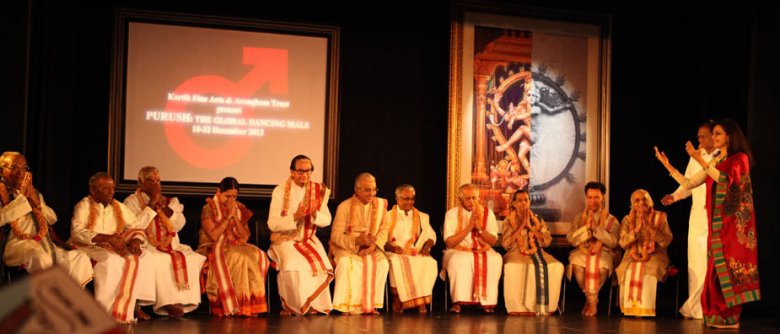 Honoring of the gurus 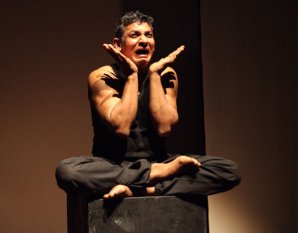 Vinay Kumar 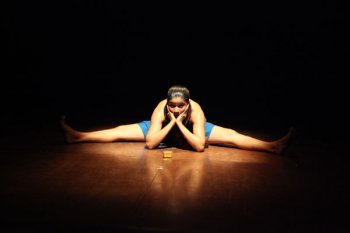 Nimmy Raphel The festivities start on two evenings at the Alliance Francaise, where Adishakti (Veenapani Chawla) showcased two works, THE TENTH HEAD and NIDRAVATHWAM and everyone was talking about Vinay Kumar and Nimmy Raphel. Day One of the Purush Conference starts on 20th December, and all the usual suspects are there: critics from far and near; conference addicts; locals dressed up in best silks (which other month can give them an opportunity to dress so?) and the odd, true rasika, somewhere in middle or back rows, afraid to come close to these professional looking types. Madras is most symbolic of power structure and many layers that exist in Indian dance world, and this is not exclusive to Madras but has gone to Odisha now. You are somebody only if you are in the front row. In this particular hall, with the seats unusually high and the row angle being concave, it is a sure recipe for spondilitis or worse. Madras is MADras but Delhi was always the capital of all things unique. Of late, late entrants (VIPs) slip in on back rows, unless chief guesting. Bombay and Bangalore remain professional and cosmo. That means anything goes! Hyderabad… let's wait and watch where it ends up, in which State. Sorry, Kolkata, you are not to be seen anywhere. Leela Venkataraman, the Hindu critic from Delhi, starts the Opening Address with logic and ends with a lament: male dancers are in the minority and are a marginalized lot. The going is tough. Opportunities, few etc. What she says is true and nothing new. Problem we all know, what's the solution? How do we help solve it? Look at it practically: When choosing a good dancer, the ratio of available good options is generally 99/1 women vs. men. Say, when we sit on Khajuraho or Konark or Kinnaur dance festival selection committee, while many women dancers qualify, in almost all forms, one should see if comparable male dancers are there and give them a chance to dance. Simple. Do this for next 5 to 7 years and many males would have arrived on the national dance scene. Look at Odisha and Odishi. There are as many male dancers as females. Kathak too. Only Bharatanatyam suffers from this lopsided sex ratio. Manipuri, Mohiniattam, Kathakali remain true to form. Devdutt Pattanaik is loud and clear, as motivational speaker, writer on urban legends, myths, ought to be. His text is minimal while his ideas from maximum city are lucid and lovely. Anita wields the whip, urging all her captive flock not to attend Devdutt's new book on Sita launch function next evening….as she wants all of us in the BVB hall next 3 days... for, by, of PURUSH! Dancer Pavitra Bhat from Bombay got a place of honour to start the Purush proceedings. His dance is rather angular and jumpy with no repose. His performance was quite mechanical. In his closing address, Rustom Bharucha referred to such dance as described by Chandralekha in 1984 East West Conference as dollification, but I am calling it mollification! Once curtains came down after his brief performance, Anita Ratnam welcomed all and set the tone for the proceedings. Anita Ratnam returned to India some 25 years ago after about 15 years in the US of A. Since then she has helped re-energise the dance space with her interventions. That Narthaki directory was the first data base the various national bodies had failed to compile for many decades but she did. Next, she and Ranvir Shah started The Other Festival which brought the dead Egmore Museum hall to life. Hiring just two able staff Lalitha Venkat and Sumathi, she next mounted dance portal www.narthaki.com, clearly the most visited dance site and portal for addresses, info, views, previews and reviews. Now Anita mounts these action-packed 3/5 days seminar based dance gatherings at BVB with Kartik Fine Arts. She also dances, writes, travels, connects, mentors and advises. Add being a full-time single mom to two and you wonder if it is still one person we are talking about! All talents she supports may not have gold standards but at least she is positive. When we chose to put her on BN issue cover (2000 attendance) many were aghast. "Aiyo, this America returned novice, on the cover? Are WE dead?" 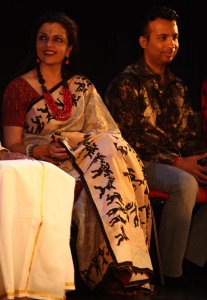 Anita Ratnam, Hari Krishnan 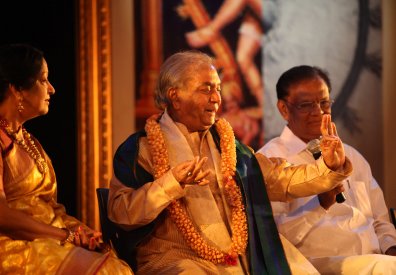 Padma Subrahmanyam, Pt Birju Maharaj, Sabaretnam Dead meat her partner-in-crime, Hari-O-Hara (Hari Krishnan) would have been, had he excluded anyone from being on stage, so almost all were included. Dancers good, bad, ugly. Past masters of dance and dance writing and all devas (counterpart of divas!). With gelled hair and designer shirts with jeans, I don't profess to know much about Prof. Hari except that he has been in the news for Mandooka Sabdam and the consequent Bessie Awards nomination and his Wesleyan University US connection. Wesleyan to us mean Bala amma family; Vishwa, Lakshmi, Judy, Medha…all gone. Prof. Hari also has Toronto links. Presently, deep in snow. Hari writes to me post Purush that his first link to us Khokars was long ago when the first paper he was made to write as a PhD student was on my mother M.K. Saroja and her guru Muthukumara Pillai. The first book on dance he read was my father's. Like many others told me after my session on Day 2, he writes he liked the content and tone of my 45 minute discourse on MALE MOVES. The films I've saved, made and compiled were a delight, he adds. Especially on Ted Shawn. Many liked the rare documentation shown. I have 2000 hours of dance films and to compress that in 20 minute frame for a specific subject is a herculean task but I try and sometimes succeed. Dance is a visual medium, no point talking about it or pontificating too much. So when one hears about Ram Gopal, Ted Shawn, Uday Shankar, Birju Maharaj, Astad Deboo and sees them on screen, the connection is immediate. Visual impressions remain long after the spoken word. I thought the only bad part in the films was me (footage from DD dance series 'Taal-Mel' made with Sharmishtha Mukherjee) but after the session, while many compliment me, one woman complains: You looked so good then what happened now? I am amused because the woman who says this has more salt-pepper hair than I do, so I say, life! (Life happened!). Sabaretnam, the ratna of Kartik Fine Arts and BVB, tells me on the last day that Devdutt's and my discourse were the two sessions he liked and enjoyed most. Madras is a tough nut to crack because it has remained insular for thousands of years, so the natives have no counter point or outside view and are often not used to sharing or being generous easily like the rest of India (partly because rest of India suffered invasions and more). Madras takes warming up even if it remains hot for most of the year. 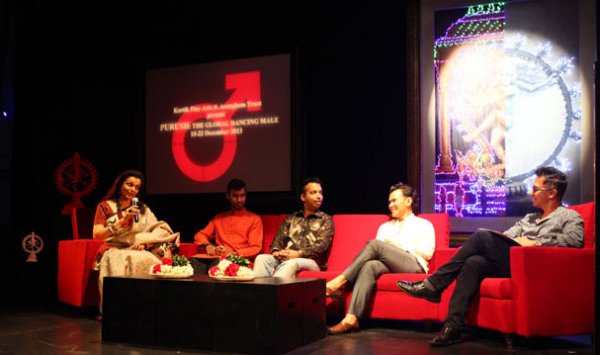 Anita Ratnam, Sooraj Subramaniam, Hari Krishnan, Ramli Ibrahim, Jay Pather Hari's own session with Jay Pather, Sooraj Subramaniam and Ramli Ibrahim were the most meaningful for me. These angst-driven men, all possessed by some personal cause and concern, have shaped dance, not the other way around. This is my take home lesson. Classical dancers were shaped by the dance; contemporary dancers are shaping dance. Anita said in her intro of my session that 15 years of attendance has profiled many male dancers and in some trajectory, many new all-male dance festivals have taken roots in Bhubaneswar, Baroda, Bombay, Chennai. In Bangalore, we not only give maximum chance in dance to male talents but have instituted all male awards named after Ram Gopal, Mohan Khokar, Uday Shankar and USK Rao. Ramli Ibrahim, Navtej Johar, Murali Mohan Kalva, Jayachandran Pallazhy, Praveen Kumar, Satyanarayana Raju, Sanjay Shantaram and Rahul Acharya have got these in past 5 years. They get to perform in many new venues and some even go on residencies abroad. Praveen went to TTB, Italy. Murali group to WCR, Sweden. One can make a difference if one wishes to. The Aam aadmi can change the set system ...Arvind Kejriwal has just shown us how! 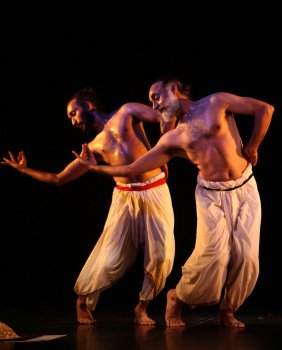 Sudeep Kumar & Navtej Johar 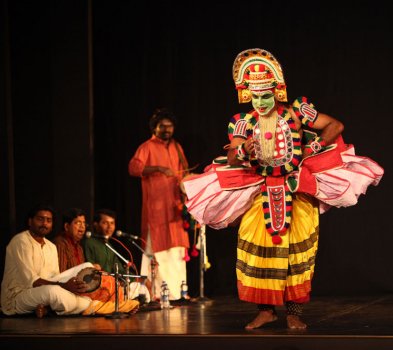 Suresh Kaliyath 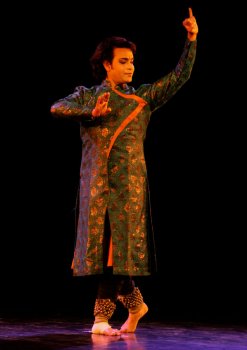 Anuj Mishra ; Photo: Nikhita Kapoor 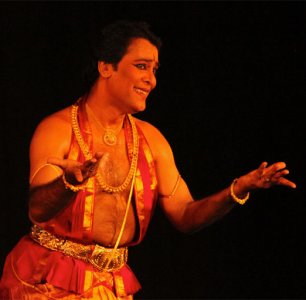 A Lakshmanaswamy ; Photo: Nikhita Kapoor Oh yes, can one forget the very engaging evening performances? Navtej (with thinner look-alike Sudeep) was at his sublime, slow best. Ottan Thullal Suresh Kaliyath captivated all with electrifying performance, the best one has seen in ages. Anuj Mishra hardly warmed up when his time was up. Pathetic Kuchipudi from Vempati school because basic stances were ill maintained. Sinam Basu's Manipuri gave an overall feel of Bollywood. 15 minute slots don't do justice. 20 is minimum, even for a truncated varnam to be savoured. A. Lakshmanaswamy, the current flavor of male BN dancing and teaching in Madras, has a very mature and controlled approach to dance and his best aabhushana (jewellery) is his smile. He must watch his weight though and not become podgy. A good dancer will be lost. Chitra Sundaram, Avanthi Meduri and Dr. Ann David (Head of Dance and Reader in Dance Studies at the University of Roehampton, London) made for the UK contingent. Wish more time was at hand for a real researcher like Ann David to have elaborated on anything meaningful and wish Sandra Chatterjee (PhD student from Stuttgart, working on Uday Shankar as a case study) had edited hers. Anil Srinivasan's piano was perfectly tuned as was the dimpled-cheek new boy on the block, Sikkil Gurcharan's vocals. Kiran Rajagopalan sat and showed abhinaya a la Kalanidhi, only he is not Kalanidhi (just using face and not dancing with the whole body). Tribhuvan Maharaj, grandson of Birju Maharaj made his Madras debut with winsome smile and beautiful hastas. Dance is his DNA and it shows. Senior streevesham talent Kalakrishna and veteran guru Birju Maharaj concluded the last evening. 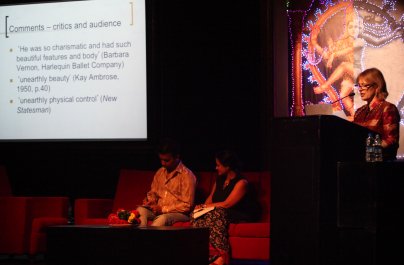 Hari Krishnan, Sandra Chatterjee, Ann David 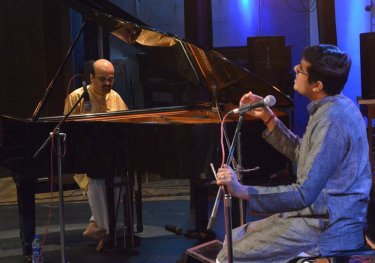 Anil Srinivasan, Sikkil Gurucharan ; Pic: Hariharan Sankaran 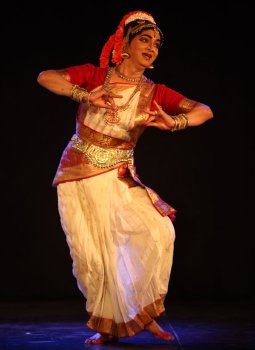 Kalakrishna 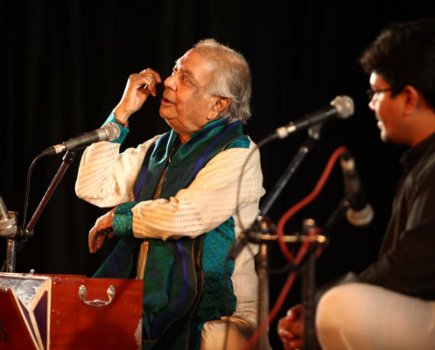 Pt Birju Maharaj So what did Purush achieve? It brought many global talents together. It made space for discussion. Debate was avoided by polite society of Madras. Sexual agendas and concerns remained hidden, as Article 377 had just been revoked by no less than the Supreme Court. Anita was epitome of conveying this diplomatically in her opening remarks. Rustom Bharucha, Dean of Arts and Aesthetics Dept, JNU, summed up all strains very well and this international talent knows his marbles well. He is an effective theatrical speaker with voice modulation and correct diction. Did Purush 2013 event say anything new? If only one could listen to lines in between. Gurus remained status quo about context and concerns. Young dancers hardly got a chance to speak as time was limited and seniors dominated. Many active teachers shared concerns happily but agreed with what was said by experts. All in all, a nice party was had by all and that's rare in dance gatherings. But Anita-Hari bring positivity by being inclusive to all. The honouring of 10 great gurus - all males - was poignant with an excellent tongue-in-cheek commentary on each by Lakshmi Vishwanathan. For me, the naming and celebrating of all team members who helped with lights, hall, hosting, meant the most, as these people work tirelessly and rarely get noticed. When we brought out 2009 attendance issue on Male Soloists, one male dancer, Murali Mohan Kalva, summed it up well: "We were dancing before and will continue to do so in the future." Amen! I mean, Ah men!  Ashish Mohan Khokar has used his training in many forms, exposure to all greats from childhood and vast visual and photo memory to document and record dance heritage and history. He wrote dance column in Delhi for SPIC MACAY's The Eye and Firtscity magazine for over a decade, was dance critic for Times of India for two decades in Delhi then Bangalore. He has authored and published 40+ books to date, edits and publishes India's only yearbook on dance - attendance - now in its 15th year. He is the keeper and curator of The Mohan Khokar Dance Collection, India's largest dance archival materials. He is associated with Baroda, Bangalore and Bombay universities and mentors many young talents, especially male dancers through his popular academic Dance DISCourse Series in Bangalore at Alliance Francaise.  Response * An article on male dancers by a person, who seems to understand male dancers, yet not able to comprehend the reality. The whole article wiggles and waggles between subjects. India is still a society which believes, all males should earn and dancing is not a way to support the family. In spite of this statement, many do go ahead and work their way up and mostly end up as teachers. Rarely do we see a combination of teachers and performers. Apart from this, most male dancers do not venture into male aspect (apart from the mythology), to go deep into the meaningful male oriented active dancing, as if there is no real problem for men. If there is any new dance happening, it is still in a very low minority, and it is not attracting "male" audience, which otherwise gets attracted to female beauty. Audience may relish, when a male dancer comes out portrays his supremacy of dancing through male potent subject. Men should dance like men; they should tell stories of man and think out of the box to make male dancing more relevant to the society. I guess, critics like Mr. Ashish Khokar should sit and watch the performances of male dancers, whether those male dancers were good friends of these critics or not. - Prasanna Kasthuri (Jan 24, 2014) Post your comments Pl provide your name and email id along with your comment. All appropriate comments posted with name and email id in the blog will also be featured in the site. |